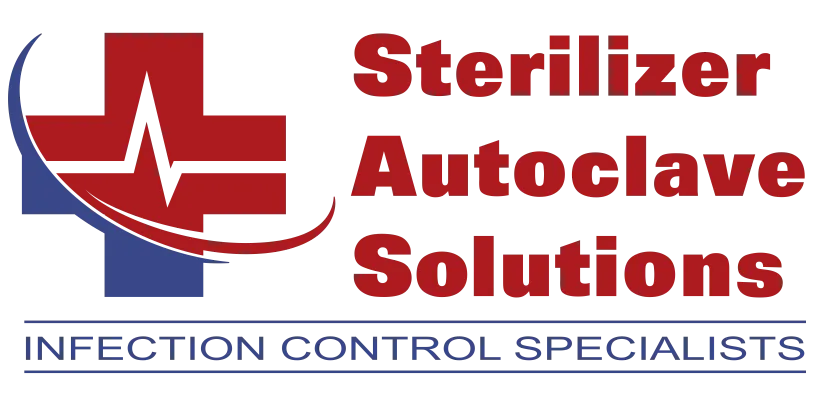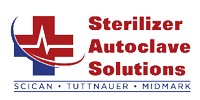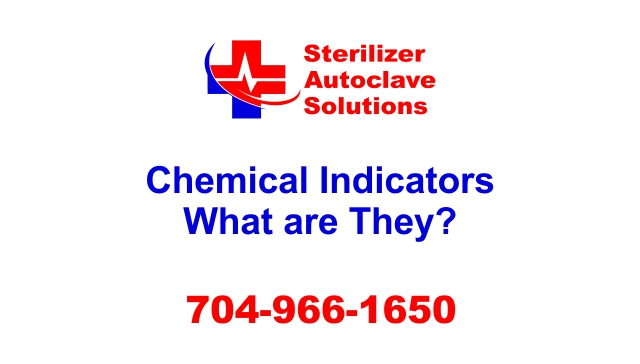Chemical Indicators – What And Why? Leave a comment
What is a Chemical Indicator?
Chemical indicators are an instrument used to see if the sterilization parameters are completed for a particular sterilization process. A chemical indicator will go through a physical or chemical change after being exposed to fixed critical parameters like time or temperature). This change is visible to the operator and will be interpreted as a pass or fail. These results help the staff to decide if a load has been properly sterilized and can be released for use. And if you just want to talk to someone, call our Free Tech Support at 704-966-1650 Option 3.
Physical Changing Indicators
A Steam Indicator Strip is one type of chemical indicator that goes through a physical change during a test. This type of indicator uses a solid chemical pellet that will change to liquid when it is exposed to steam. The liquid then seeps along a paper strip that is visible in the window of the chemical indicator allowing the operator to see the results of the test.
Chemical Changing Indicators
A chemical changing indicator uses a chemical reaction by one or more chemicals in the indicator ink to create a change in the testing indicator. The chemical or chemicals will change the color of the ink when reacting to critical parameters which again allows the operator to see the results of the test.
Using Chemical Indicators for Steam Sterilization
Chemical indicators are required when using a steam sterilization process to verify that the critical parameters of the cycle were met. The indicator type and sterilization cycle will determine the way chemical indicators are used in an autoclave. When using chemical indicators for sterility assurance monitoring, staff should always follow the manufacturer’s instructions for use. They should use healthcare compliance organizations’ guidelines and requirements as well.
The Different Types of Chemical Indicators
According to ANSI/AAMI ST79 Comprehensive guide to steam sterilization and sterility assurance in health care facilities1, internal chemical indicators can be a Type 3, Type 4, Type 5, or Type 6. However, Types 5 and 6 are preferred for internal pack monitoring as they provide the user with more information on critical sterilization parameters.1
The following is a list of the chemical indicator types, what they indicate, and an application example.
| Types of Chemical Indicators | ANSI/AAMI/ISO Definition | Practical Application |
|---|---|---|
| Class 1: Process Indicator | “Process indicators are intended for use with individual units (e.g., packs, containers) to indicate that the unit has been directly exposed to the sterilization process and to distinguish between processed and unprocessed units. They shall be designed to react to one or more of the critical process variables.” | Indicator Tapes, Indicator Labels, or Load Cards that are placed on the outside of a pack for exposure control. |
| Class 2: Specific Use | “Class 2 indicators are intended for use in specific test procedures as defined in relevant sterilizer/sterilization standards.” | Bowie Dick Test used to check the efficiency of the air removal and steam penetration within the chamber |
| Class 3: Single Variable | “A single variable indicator shall be designed to react to one of the critical variables and is intended to indicate exposure to a sterilization process at a stated value (SV) of the chosen variable.” | Single variable indicators may be used for pack control monitoring but would not provide as much information as a Class 4, Class 5, or Class 6 Chemical Indicator. |
| Class 4: Multi-Variable | “A multi-variable indicator shall be designed to react to two or more of the critical variables and is intended to indicate exposure to a sterilization cycle at SVs of the chosen variable.” | Multi-variable Chemical Indicators are used for pack control. These internal Chemical Indicators are usually paper strips printed with a Chemical Indicator. |
| Class 5: Integrating Indicators | “Integrating indicators shall be designed to react to all critical variables. The SVs are generated to be equivalent to or exceed the performance requirements given in the ISO 11138 series for BIs.” | Integrating Indicators are the only Chemical Indicators required to have three Stated Values (SVs) that correlate to the performance of Biological Indicators (BIs). Also, the SV at 121°C must be greater than 16.5 minutes to ensure performance is comparable to BIs in saturated steam. Integrating Indicators can be used for pack and load control monitoring. For load control monitoring: • the Class 5 Integrating Indicator must be used in the appropriate Process Challenge Device (PCD). • a PCD containing a Class 5 Integrating Indicator is an option for the release of non-implant loads. • for loads containing implants, AAMI ST79 recommends the use of a BI PCD that also contains a Class 5 Integrating Indicator. • in defined medical emergencies only, the Class 5 Integrating Indicator in the BI PCD can be used for early release of implants. |
| Class 6: Emulators, or Cycle Specific Indicators | “Emulating indicators are cycle verification indicators which shall be designed to react to all critical variables for specified sterilization cycles. The SVs are generated from the critical variables of the specified sterilization process.” | Emulating Indicators are designed for specific sterilization cycles, and should only be used to monitor the specific cycle for which they are labeled. Emulating Indicators can be used for pack and load control monitoring. For load control monitoring: • the Class 6 Emulating Indicator must be used in the appropriate PCD. • a PCD containing a Class 6 Emulating Indicator is an option for the release of non-implant loads. • for loads containing implants, a PCD containing a Class 6 Emulating Indicator can be used as an additional load control monitoring tool along with a BI/Class 5 PCD; however, a Class 6 PCD should not be used to release implants instead of a BI/Class 5 PCD. |
With the changing face of sterilization that has come about post-Covid-19 it is time to brush up on all the methods that are used. Steam sterilization is just one of many areas that have always seemed to be a “that’s good enough” mentality. That will not cut it anymore with the CDC, FDA, AMA, and ADA amongst others ramping up the control and monitoring of these processes.
Please feel free to contact us if you have any other steam sterilization questions. We always offer FREE TECH SUPPORT even if you have never purchased from us.
View the Chemical Indicators we have available.
As always if you have any questions about this process or anything else please feel free to contact us and take advantage of our “FREE TECH SUPPORT.”
We also offer FREE VIRTUAL TECH SUPPORT to “See and Talk” with a “Real Time Live Technician” for any problems you may be in need of help with.
You can also use our “FREE MAINTENANCE PROGRAM”. Take the guesswork and worrying about what unit is due for maintenance and which maintenance cycle it is time for. We will keep track of all your autoclaves and let you know when it’s time for anything.


